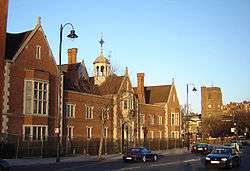Crosby Hall, London
| Crosby Hall | |
|---|---|
 | |
| Location | Cheyne Walk, Chelsea, London |
| Coordinates | 51°28′56.94″N 0°10′21.52″W / 51.4824833°N 0.1726444°WCoordinates: 51°28′56.94″N 0°10′21.52″W / 51.4824833°N 0.1726444°W |
| Built |
1466 (Great Hall and Parlour) 1910, 1925–6 (Remainder) |
Listed Building – Grade II* | |
| Official name: Crosby Hall | |
| Designated | 24 June 1954[1] |
| Reference no. | 203744 |
 Location of Crosby Hall in Greater London | |
Crosby Hall is a historic building in London. The Great Hall was built in 1466 and originally stood in Bishopsgate, in the City of London, but was moved in 1910 to its present site in Cheyne Walk, Chelsea. It now forms part of a private residence. The Great Hall, and additional work of 1910 and 1925–6, are listed Grade II*.[1][2] Although fragmentary and not on its original site, this is the only example of a medieval City merchant house surviving in London.[2]
History
Bishopsgate
The Great Hall is the only surviving part of the medieval mansion of Crosby Hall, Bishopsgate, in the City of London, which was built in 1466 by the wool merchant Sir John Crosby. By 1483, the Duke of Gloucester, later Richard III, had acquired the Bishopsgate property from the original owner's widow.[3] The Hall was used as one of his London homes.[3] It was used as the setting for a scene in William Shakespeare's Richard III.[4] In the reign of Henry VIII it belonged to Antonio Bonvisi.[5]
From 1621 to 1638 it was the home of the East India Company.[6][7] Following a fire in 1672 only the Great Hall and Parlour wing of the mansion survived; it then became a Presbyterian meeting house, and then a warehouse with an inserted floor.[1]
Chelsea
In 1910, the medieval structure was reprieved from threatened demolition and moved stone by stone to its present site, provided by the former London County Council, largely at public expense.[8] The neo-Tudor brick additions designed by Walter Godfrey were constructed around it. The salvage, catalogue and storage were paid for by the Bank of India, who had purchased the Bishopsgate site to build offices.[9] In 1916, the building housed Belgian refugees, as noted in an essay by Henry James.[10]
Godfrey also added the north wing in 1925–6 as a women's university hall of residence for the British Federation of University Women. The site passed to the Greater London Council (GLC), who maintained it until 1986, when the GLC was abolished. The London Residuary Body, charged with disposing of the GLC's assets, put Crosby Hall up for sale.
Crosby Hall was bought in 1989 by Christopher Moran, a businessman who is the Chairman of Co-operation Ireland. Until then the site's frontage had been open to Cheyne Walk and the River Thames and its central garden was open to the public. Moran commissioned a scheme to close the frontage with a new building and convert the complex to a luxury mansion. The scheme caused considerable controversy, but was given permission after a Public Inquiry in December 1996, following two previous refusals by Kensington and Chelsea Council.
Notable residents at the original site
- Richard Duke of Gloucester 1483.[1]
- Bartholomew Reade, Lord Mayor of London, 1501 - 1505[11]
- Sir Thomas More 1523–4.[1]
- William Roper (son-in-law of Thomas More), 1547.[1]
- Sir Walter Raleigh 1601.[1]
- Owned by the Earl of Northampton between 1609 and 1671,[1] and the residence of poet Mary Sidney from 1609 to 1615.
- Headquarters of the East India Company 1621–38.[1]
- Crosby Hall
- Crosby Hall
- Crosby Hall
- Crosby Hall
- Crosby Hall
- Crosby Hall
See also
| Wikimedia Commons has media related to Crosby Hall. |
References
- 1 2 3 4 5 6 7 8 9 "Crosby Hall". Images of England. English Heritage.
- 1 2 Historic England. "Crosby Hall (Grade II*) (1358160)". National Heritage List for England. Retrieved 8 January 2017.
- 1 2 Amy Licence. Anne Neville: Richard III's Tragic Queen, Amberley Publishing. 2013.
- ↑ "Local architecture". Royal Borough of Kensington and Chelsea. Archived from the original on 29 April 2010. Retrieved 6 June 2010.
- ↑

- ↑ Foster 1913.
- ↑ http://www.british-history.ac.uk/no-series/london-inhabitants/1638/pp69-70
- ↑ Godfrey 1982.
- ↑ Godfrey 1913.
- ↑ James, Henry (23 March 1916). "Refugees in Chelsea". Times Literary Supplement (740): 133–34.
- ↑ Chaffers, William "Gilda Aurifabrorum" pg. 35-36
Further reading
- Foster, Sir W. (1913). "The East India Company at Crosby House, 1621–38". London Topographical Record. 8: 106–39.
- Godfrey, W. Emil (1982). "Crosby Hall and its re-erection". Transactions of the Ancient Monuments Society. n.s. 26: 227–43.
- Godfrey, Walter H. (1913). "Crosby Hall (re-erected)". Chelsea, Pt II. Survey of London. 4. London. pp. 15–17.
- Knight, Charles, ed. (1841). "Crosby Place". London. 1. London: Charles Knight. pp. 317–32.
- Norman, Philip (1909). "Crosby Place". London Topographical Record. 6: 1–22.
- Norman, Philip; Caröe, W. D. (1908). Crosby Place. Survey of London Monograph. 9. London.
- Saint, Andrew (1991). "Ashbee, Geddes, Lethaby and the Rebuilding of Crosby Hall". Architectural History. 34: 206–23. JSTOR 1568600.
- Sweet, Rosemary (2017). "The preservation of Crosby Hall, c.1830-1850". Historical Journal. 60: 687–719.
- Thurley, Simon (2003). "Crosby Hall – 'the most important surviving domestic medieval building in London'". Country Life. Vol. 197 no. 40. pp. 72–5.
External links
- Historic England. "Crosby Hall (Grade II*) (1358160)". National Heritage List for England. Retrieved 8 January 2017.